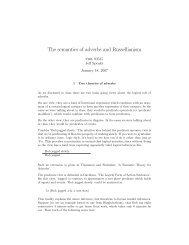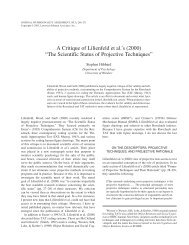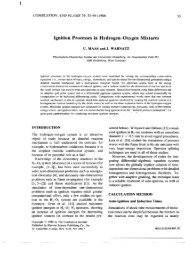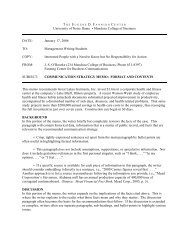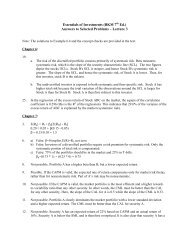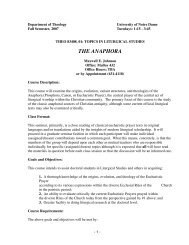Theory of IVP and Euler's Method
Theory of IVP and Euler's Method
Theory of IVP and Euler's Method
You also want an ePaper? Increase the reach of your titles
YUMPU automatically turns print PDFs into web optimized ePapers that Google loves.
5.1 Elementary <strong>Theory</strong> <strong>of</strong> Initial-Value Problems<br />
Definition: A function is said to satisfy a Lipschitz condition in the variable on a set if a constant<br />
exists with<br />
whenever <strong>and</strong> are in . The constant is called a Lipschitz constant for .<br />
Example. Show that satisfies a Lipschitz condition on the interval {<br />
.<br />
Solution: For arbitrary points <strong>and</strong> in , we have<br />
|( ) ( )|<br />
Thus satisfies a Lipschitz condition on in the variable with Lipschitz constant .<br />
Definition: A set is said to be convex if whenever <strong>and</strong> belongs to <strong>and</strong> , the point<br />
also belongs to .<br />
Remark: 1. Convex means that line segment connecting <strong>and</strong> is in whenever <strong>and</strong> belongs to .<br />
2. The set { is convex.<br />
Theorem 5.3 Suppose is defined on a convex set . If a constant exists with<br />
for all , then satisfies a Lipschitz condition on in the variable with Lipschitz constant .<br />
Existence <strong>and</strong> Uniqueness<br />
Theorem 5.4 Suppose that { <strong>and</strong> that is continuous on . If satisfies a<br />
Lipschitz condition on in the variable , then the initial-value problem (<strong>IVP</strong>)<br />
has a unique solution<br />
for<br />
1
Example 2. Show that there is a unique solution to the <strong>IVP</strong><br />
Solution:<br />
<strong>Method</strong> 1. Use Mean Value Theorem in , we have<br />
for in .<br />
Thus, .<br />
satisfies a Lipschitz condition on in the variable with Lipschitz constant<br />
Additionally, is continuous on { . Thm 5.4 implies that a unique<br />
Solution exists.<br />
<strong>Method</strong> 2. The set { is convex. | | . So satisfies<br />
a Lipschitz condition on in the variable with Lipschitz constant<br />
Additionally, is continuous on { . Thm 5.4 implies that a unique<br />
Solution exists.<br />
Well-Posedness<br />
Definition: The <strong>IVP</strong><br />
is said to be a well-posed problem if:<br />
1. A unique solution , to the problem exists, <strong>and</strong><br />
2. There exist constant <strong>and</strong> such that for any with , whenever is continuous with<br />
for all in , <strong>and</strong> when , the <strong>IVP</strong> (a perturbed problem associated with original )<br />
has a unique solution<br />
that satisfies<br />
Why well-posedness? Numerical methods always solve perturbed problem because <strong>of</strong> round-<strong>of</strong>f errors.<br />
2
Example. Consider the original problem<br />
The solution is<br />
The associated perturbed problem is with <strong>and</strong> being constants.<br />
Assume <strong>and</strong> The solution is<br />
So<br />
Theorem 5.6 Suppose { <strong>and</strong> that is continuous on <strong>and</strong> satisfies a Lipschitz<br />
condition on in the variable , then <strong>IVP</strong><br />
is well-posed.<br />
Example. Show the <strong>IVP</strong><br />
is well-posed on {<br />
Solution: | |<br />
Function<br />
satisfies Lipschitz condition with L =1. So Theorem 5.6 implies the <strong>IVP</strong> is well posed.<br />
3
5.2 Euler’s <strong>Method</strong><br />
Algorithm description<br />
Suppose a well-posed <strong>IVP</strong> is<br />
Distribute mesh points equally throughout<br />
The step size<br />
We compute the approximate solution at time points<br />
by:<br />
Here , namely, is the approximate solution at time<br />
Difference Eq.<br />
Example. Solve<br />
Solution:<br />
numerically with time step size<br />
Derivation <strong>of</strong> Euler’s <strong>Method</strong><br />
Use Taylor’s Theorem for<br />
for Since <strong>and</strong> ( )<br />
Neglecting the remainder term gives Euler’s method for :<br />
( )<br />
4
Geometric interpretation <strong>of</strong> Euler’s <strong>Method</strong><br />
implies is an approximation to slope <strong>of</strong> at .<br />
Error bound<br />
Theorem 5.9 Suppose { <strong>and</strong> that is continuous on <strong>and</strong> satisfies a<br />
Lipschitz condition on in the variable with Lipschitz constant <strong>and</strong> that a constant exists with<br />
Let<br />
<strong>and</strong><br />
denote the unique solution to the <strong>IVP</strong><br />
as in Euler’s method. Then<br />
[ ]<br />
Example. The solution to the <strong>IVP</strong><br />
Find the bound for approximation.<br />
was approximated by Euler’s method with<br />
5
Solution: The exact solution is<br />
.<br />
So .<br />
| |<br />
Hence<br />
[ ]<br />
<strong>and</strong> so on.<br />
6



